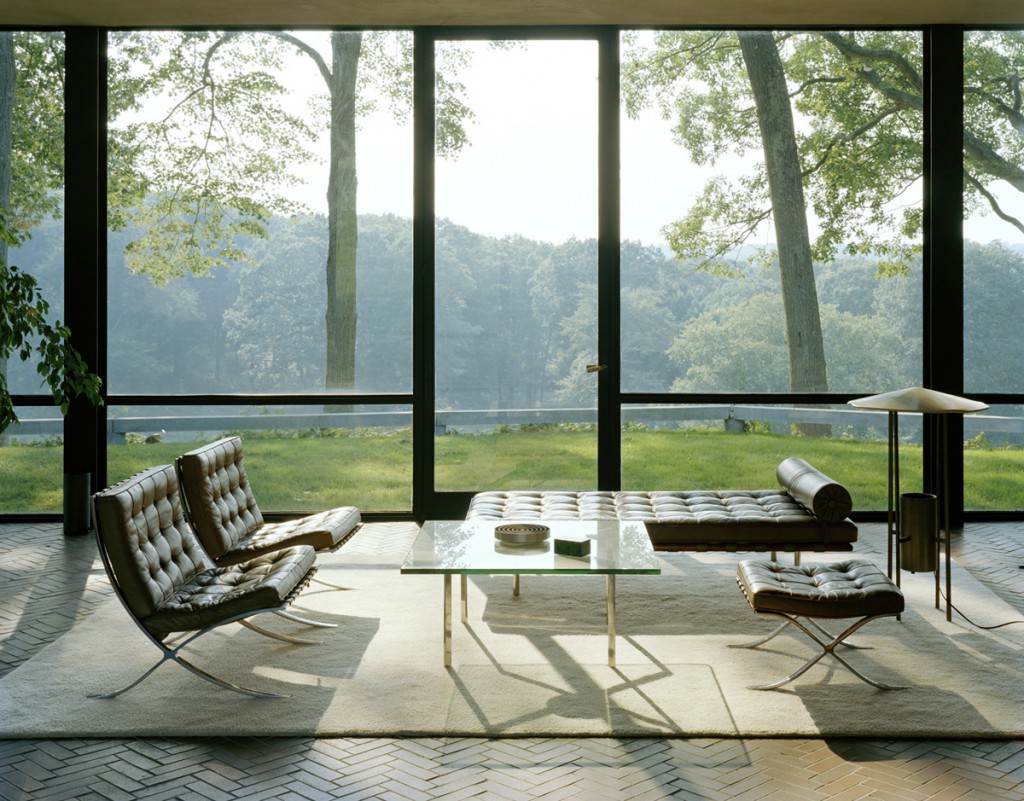Since this blog began, I have been harassing my friend and New York University colleague Pepe Karmel, well known art historian, curator and critic of contemporary art, to make a contribution to the ongoing discussion. Happily, The Philip Johnson Glass House staff decided to enlist him too, so we have all joined forces. The Glass House, completed in 1949, was Johnson’s private residence, and it is considered to be one of his greatest architectural achievements. Inspired by Mies van der Rohe’s Farnsworth House, the building has exterior walls of glass and no interior walls. It sits on 47 acres of land in New Canaan, Connecticut (which are home to supplementary buildings and works created by the artist over a period of 50 years), and the entire campus has been named a National Trust Historic Site by the U.S. Government.
Before practicing architecture, Johnson was the founding Director of the Department of Architecture at the Museum of Modern Art in New York, and curator of the famous 1932 exhibition, “The International Style.” As a trustee and patron of MOMA for many years, he donated more than 2,000 works, by artists as esteemed as Jasper Johns and Robert Rauschenberg, to the institution. Johnson’s close ties to the art world, and to its most important movers and shakers, inspired him and his partner, David Whitney, to use the Glass House as a meeting place for the great cultural players of his time. Conversations with people like Andy Warhol, Frank Stella and Robert A.M. Stern became legendary, and Vincent Scully called these gatherings “the most sustained cultural salon that the United States has ever seen.”
After the deaths of both Johnson and Whitney in 2005, The Glass House continued to host these conversations. In 2010, partnering with graduate students from the School of Visual Arts in Manhattan, the staff created an expanded digital forum. Accessible at www.glasshouseconversations.org, the site proposes provocative questions or debate topics, and by now 20,000 people from 150 countries have participated in the ensuing exchanges. The question posed to Pepe Karmel by Glass House Conversations recently is indeed a hot button, and often controversial, issue:
Is the United States still the leader in innovative new art as it was in the latter half of the 20th century?
Here is Karmel’s reply, as it was posted on the Glass House Conversation web site. Readers are encouraged to continue the discussion, of course, by publishing comments here or contributing responses to glasshouseconversations.org.
SR
If there is an avant-garde today, its very nature contradicts the assumptions implicit in the question. Why should we assume that the most important new art of a given era will be associated with a single nation? Is it actually the case that the United States was the “leader” in new art during the second half of the 20th century? Is “new art” necessarily innovative? The idea that, at any given moment, one nation is going to be the home of the avant-garde is a translation into artistic terms of Hegel’s idea of the world-historical figure. In canonical art history, Italy carries the baton from the Renaissance until the 18th century, France is the leader from 1775 until 1945, and the United States has the historically important avant-garde from 1945 until recently. This is demonstrably wrong. What about Netherlandish art in the 17th century? German and English art in the late 18th and 19th centuries. South American, non-Western, and, yes, French art after 1945?
Specifically, I would argue that the dominance of U.S. art after 1945 is in large part a chauvinist illusion. After the triumph of Pop and Minimalism in the 1960s, U.S. art historians rewrote art history (in the 1970s) to eliminate pretty much all important art made elsewhere. Arguably, much of the most innovative art produced between 1945 and 1970 was made in and around New York. But that doesn’t entitle us to ignore the rest. Nor does it entitle us to pretend that the dominance of New York lasted beyond this 25-year period. Certainly, in the 42 years since 1970, as much or more important art has been made elsewhere as has been made in New York.
Finally, we need to question the concepts “innovative” and “avant-garde.” They are rooted in the same Hegelian model, which assumes that the “essential” events in art history are formal innovations (Cubism, geometric abstraction, Abstract Expressionism, Minimalism) that supposedly follow a coherent logic of development, and that everything else is a sideshow. In an era when Marcel Duchamp is a much more important influence than Pablo Picasso, is there any credibility left to this position? There have been few–or no–significant formal innovations since 1970. Not in the US, not elsewhere. Some critics and scholars take this to mean that the history of art came to an end in 1970, and that everything since then is an epiphenomenon. That seems absurd. Much terrific art has been made since 1970. It is distinguished, not by formal innovation, but by the way it crystallizes and expresses important experiences of life in our contemporary world. From this perspective, much of the important art of our time is being made in the former “Third World,” and addresses the experience of post-colonialism, triumphant in China, catastrophic in much of Africa, and different in different countries. If this means that the avant-garde has departed U.S. shores, so be it.
— Pepe Karmel, New York, 2012

